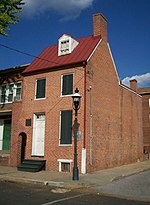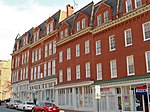Perkins Square Gazebo
Baltimore Registered Historic Place stubsBuildings and structures on the National Register of Historic Places in BaltimoreGazebosInfrastructure completed in 1871Upton, Baltimore ... and 1 more
Victorian architecture in Maryland

Perkins Square Gazebo is a historic gazebo located at Baltimore, Maryland, United States. It is an eight-sided, cast iron, open structure of eclectic Victorian design. It was constructed in 1871 and located in a triangular-shaped park in West Baltimore. It is currently located within the Heritage Crossing townhome community that was constructed on the former site of the Murphy Homes public housing project. Perkins Square Gazebo was listed on the National Register of Historic Places in 1983.
Excerpt from the Wikipedia article Perkins Square Gazebo (License: CC BY-SA 3.0, Authors, Images).Perkins Square Gazebo
Myrtle Avenue, Baltimore Sowebo
Geographical coordinates (GPS) Address Nearby Places Show on map
Geographical coordinates (GPS)
| Latitude | Longitude |
|---|---|
| N 39.295555555556 ° | E -76.629166666667 ° |
Address
Myrtle Avenue 906
21201 Baltimore, Sowebo
Maryland, United States
Open on Google Maps









